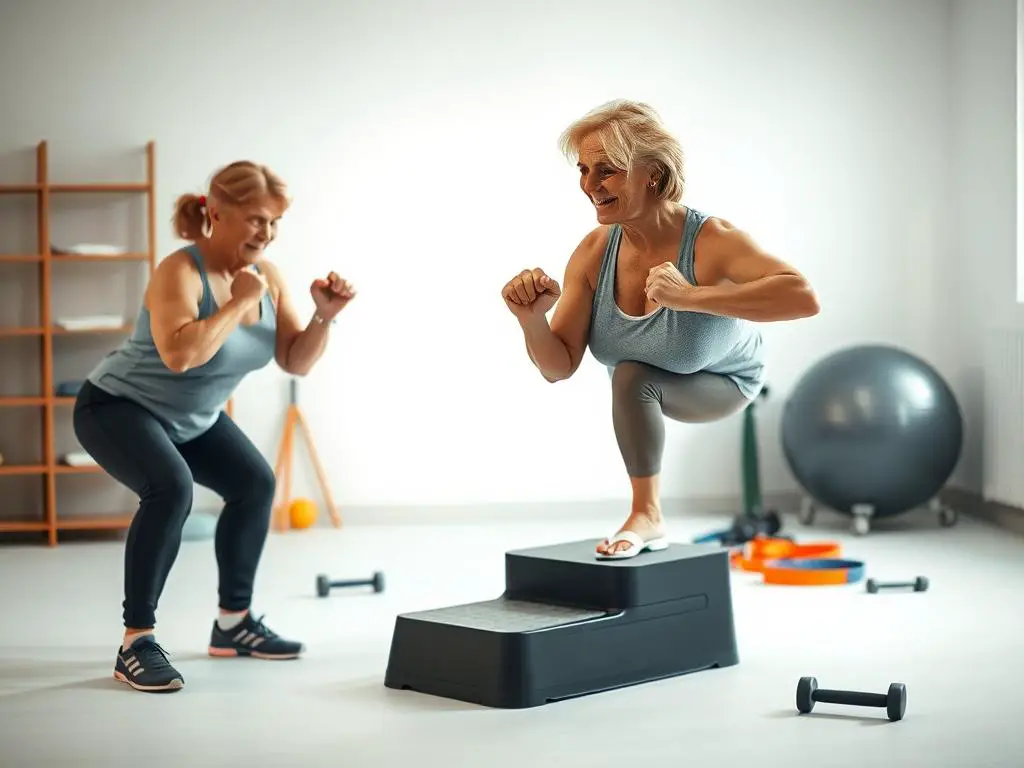Did you know that women lose up to 20% of their bone density in the first five to seven years after menopause? This fact affects millions of American women. But, the good news is that it’s never too late to take action.
As we age, our bones get weaker. This makes bone strengthening exercises for women over 60 very important. Without them, simple tasks like gardening or playing with grandkids can cause serious fractures.
Regular exercise can greatly improve bone health by creating new bone. The right osteoporosis prevention exercises for senior women increase bone density and lower fall risk. These exercises don’t need expensive gear or gym memberships.
This guide will show you safe, effective exercises for any fitness level. You’ll learn how regular movement can change your bones and boost your confidence in everyday activities.
Key Takeaways
- Women over 60 can significantly improve bone density through targeted exercise programs
- Weight-bearing and resistance exercises are most effective for preventing osteoporosis
- Balance training reduces fall risk and prevents fractures in senior women
- Starting slowly and progressing gradually ensures safety and long-term success
- Consistency matters more than intensity when building stronger bones
- Professional guidance helps create personalized exercise plans for optimal results
Importance of Bone Health for Women Over 60
As women hit their sixties, keeping bones strong is key for staying independent and enjoying life. The changes in this stage of life greatly affect bones. Women over 60 bone health importance is huge, as strong bones are the base for a future full of activity and confidence.
Menopause marks a big change for bones. Estrogen levels drop, leading to faster bone loss. This loss can last for years, affecting every woman differently but impacting bone density the same way.
Knowing about these changes helps you take charge of your bone health. This knowledge is your first defense against future problems. The choices you make today will greatly affect your mobility and independence for years to come.
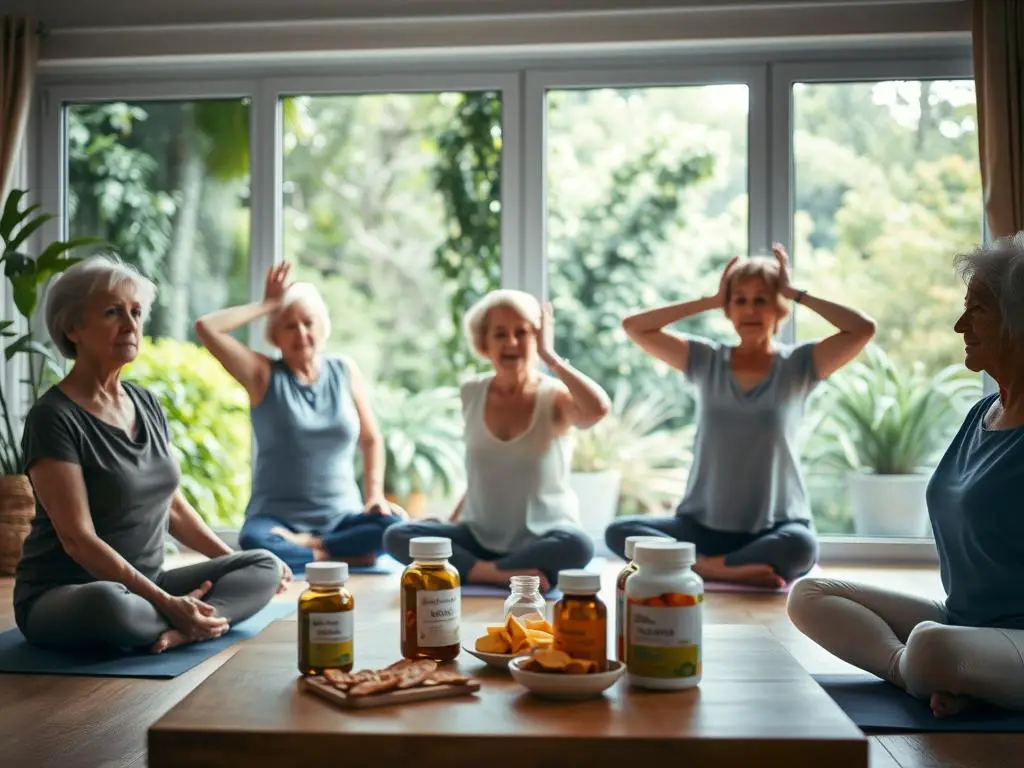
Understanding Osteoporosis
Osteoporosis is known as the “silent disease” because it shows no warning signs. Bones lose density and strength, becoming weak and fragile. Most women find out they have osteoporosis after their first fracture.
This disease affects over 54 million Americans, with women making up 80% of cases. After 50, one in two women will break a bone due to osteoporosis. These numbers show why stopping it early is so important.
Osteoporosis risk factors in elderly women include family history, small body frame, and previous fractures. It happens when bone formation can’t keep up with breakdown. After menopause, the skeleton rebuilds itself much slower.
Early detection through bone density tests can catch problems before fractures happen. The DEXA scan checks bone mineral density at key sites like the hip and spine. Regular tests help track changes and guide treatment.
Factors Affecting Bone Health
Many things influence bone strength throughout your life. Genetics play a big role, setting your peak bone mass and risk for bone loss. But lifestyle choices often have a bigger impact on your bones.
Hormonal changes are a big factor for women over 60. The drop in estrogen after menopause speeds up bone loss. Some women lose up to 20% of their bone density in five to seven years after menopause.
Not getting enough calcium and vitamin D also weakens bones. Many women don’t get half the calcium they need.
Being inactive also speeds up bone loss at any age. Sitting too much tells bones they don’t need to be strong, leading to faster wear down. Activities that make you stand or walk help keep bones strong.
Medical conditions and some medicines can also hurt bone health. Conditions like rheumatoid arthritis, diabetes, and hyperthyroidism affect bone metabolism. Some medicines, like corticosteroids and certain cancer treatments, increase bone loss risk.
Smoking and drinking too much alcohol also harm bones. Smoking lowers estrogen levels and makes it harder for the body to absorb calcium. Drinking too much alcohol stops bone formation and raises the risk of fractures.
Benefits of Strengthened Bones
Strong bones do more than prevent fractures. They are the base for an active, independent life in your golden years. Improved posture is one of the most visible benefits of healthy bones.
Being able to move around easily is another big plus. You can keep doing things you love without worrying about getting hurt. Activities like climbing stairs, gardening, and playing with grandkids become safer and more fun.
Feeling more confident is a natural result of strong bones. Many women feel safer in their daily activities after focusing on bone health. This mental boost is as valuable as the physical improvements.
Pain reduction is another big advantage of strong bones. Fractures in the spine cause chronic pain for many women with osteoporosis. Stopping these fractures through bone strengthening eliminates this pain.
Strong bones also save money. Fracture-related medical costs can be thousands of dollars. Hip fractures often need surgery, long hospital stays, and long recovery times.
Keeping independence is a big motivator for many women to focus on bone health. Strong bones reduce the need for help with daily activities. You get to keep control over your life and choices.
Healthy bones also improve overall well-being. Better balance reduces the risk of falls, and improved posture helps breathing and circulation. These benefits create a positive cycle that supports healthy aging in all body systems.
Effective Weight-Bearing Exercises
Every step you take against gravity helps strengthen your bones naturally. Weight bearing exercises for senior women create gentle stress on your bones. This encourages your body to build stronger bones. You don’t need expensive equipment or gym memberships. You can start right from your own home.
These exercises are simple yet effective. Your bones get stronger when you challenge them through movement. They adapt by becoming denser.
Understanding Weight-Bearing Activities
Weight-bearing exercises make your muscles and bones work against gravity. Activities where your feet and legs support your body weight are best. These movements stimulate bone-forming cells called osteoblasts.
There are two main types. High-impact activities include jogging, jumping, and dancing. Low-impact options include walking, hiking, and stair climbing. Both types are great for bone density exercises for women over 60.
The main difference is the force applied to your bones. High-impact exercises stimulate bones more but might not be for everyone. Low-impact alternatives are gentler on joints but still effective.
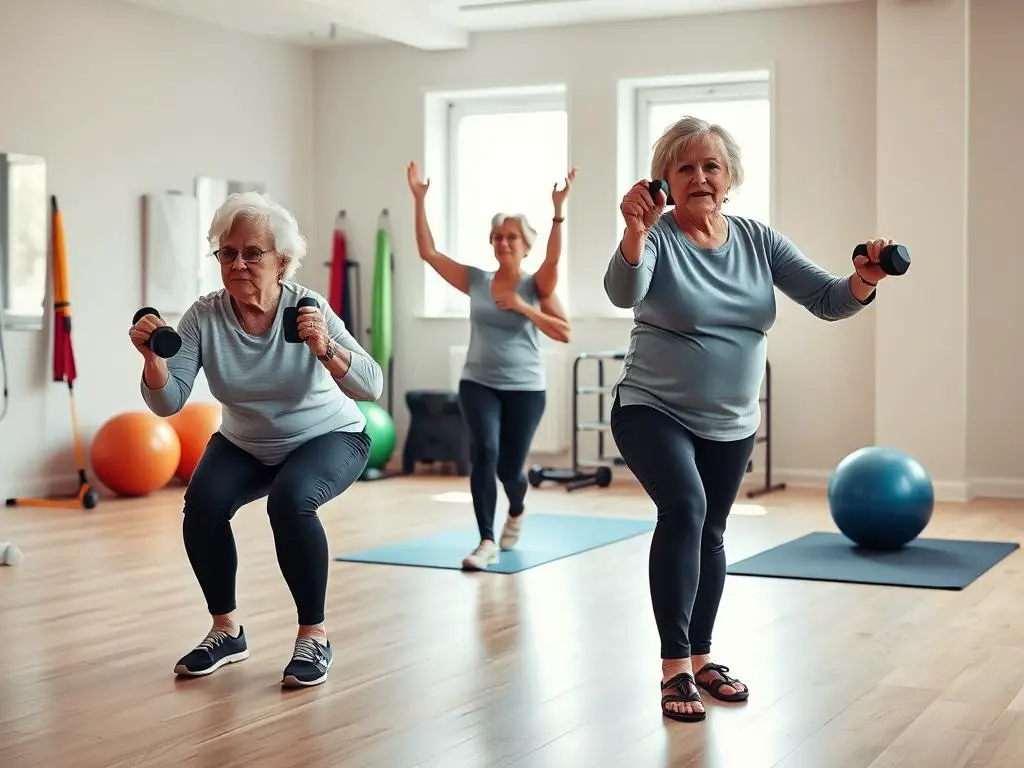
Getting Started with Beginner-Friendly Options
Starting your bone-strengthening journey is easy. Simple activities can greatly improve your bone health.
- Brisk walking – Start with 10-15 minutes daily and increase as you get stronger
- Stair climbing – Use stairs in your home or local buildings
- Dancing – Join a class or dance at home to your favorite music
- Gardening – Digging, planting, and weeding provide natural resistance
- Tai Chi – Combines gentle movement with balance training
These activities are fun rather than hard work. Choose what fits your fitness level and interests. Being consistent is more important than how hard you do it when starting.
Building Your Exercise Routine Over Time
Progress happens gradually and safely. Start with activities you can do comfortably for 10-15 minutes. Your body needs time to adapt.
Gradually increase your routine. Add five minutes to your walks each week. Include an extra day of activity when you feel ready. Listen to your body and rest when needed.
Keep track of your progress in a journal. Note how you feel before and after exercise. Celebrate small victories like walking further or climbing stairs without breathlessness. These improvements show your bones are getting stronger.
Remember that consistency trumps intensity. Three 20-minute sessions per week are better than one long, exhausting workout. Your bones respond best to regular, sustained activity over time.
Resistance Training for Stronger Bones
Resistance training is great for women over 60, offering more than just muscle gain. It puts controlled stress on bones, prompting your body to make them stronger. Strength training exercises for women over 60 help by making bones denser through muscle contractions.
This type of exercise is adaptable for everyone, no matter your fitness level. You can start with simple movements or use tools like resistance bands. This way, you can build your strength and confidence gradually.
Why Resistance Training Matters
Resistance training for elderly women bone health is backed by science. It helps slow down bone loss, which is common after menopause. Regular exercises can even help reverse some bone loss.
Resistance training stimulates bone-building cells. This means your bones get stronger and denser. Regular strength training also boosts muscle mass, which supports your bones better.
It’s not just about bones. Resistance training improves balance and reduces fall risk. It also keeps you strong for daily tasks, helping you stay independent longer.
Key Exercises to Include
The best strength training exercises for women over 60 work many muscles and build bones. You can do these with little equipment and adjust them to fit your fitness level.
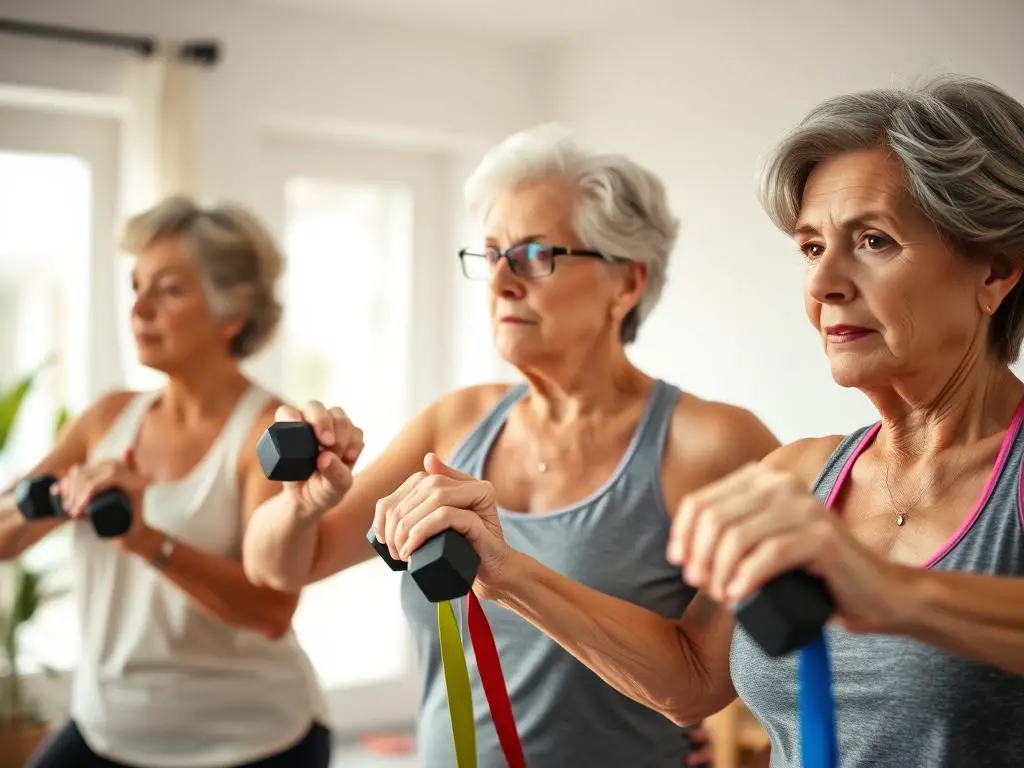
- Wall squats: Stand with your back against a wall and slowly slide down until your thighs are parallel to the floor, then return to standing
- Modified push-ups: Perform against a wall or on your knees to build upper body and arm strength
- Seated rows: Use resistance bands or light weights to strengthen your back and improve posture
- Bicep curls: Start with light weights or resistance bands to build arm strength gradually
- Heel raises: Rise up on your toes to strengthen calves and improve balance
Focus on proper form, not speed or heavy weights. Do 8-12 reps for each exercise, 2-3 sets as you get stronger. Consistency matters more than intensity for building bone density.
Safety Tips for Resistance Training
Always prioritize safety when starting resistance training for elderly women bone health. Proper preparation and technique are key to avoiding injuries.
Begin with a 5-10 minute warm-up to get your muscles and joints ready. Gentle movements like marching or arm circles increase blood flow and reduce stiffness. Never skip this important step, as warmed-up muscles and joints are less prone to injury.
Start with lighter resistance and gradually increase it. Your bones and muscles need time to adapt. Focus on proper breathing, exhaling during exertion and inhaling during release.
Working with a qualified trainer can help you learn proper form. Many fitness centers offer programs for seniors that focus on safety and gradual progression. Listen to your body and stop if you experience sharp pain or discomfort.
Remember, rest days are crucial. Your bones rebuild and strengthen during these periods. Aim for resistance training 2-3 times a week, with at least one day of rest in between. This allows your body to adapt and grow stronger without risking overuse injuries.
The Role of Nutrition in Bone Strength
Nutrition and physical activity are key for senior women to fight bone loss. Exercise helps bones grow, while nutrients provide the necessary materials. Think of nutrition as fuel for your bones.
Your body constantly works to keep bones healthy. It breaks down old bone and builds new one. Proper nutrition ensures this process works efficiently, helping bones stay strong.
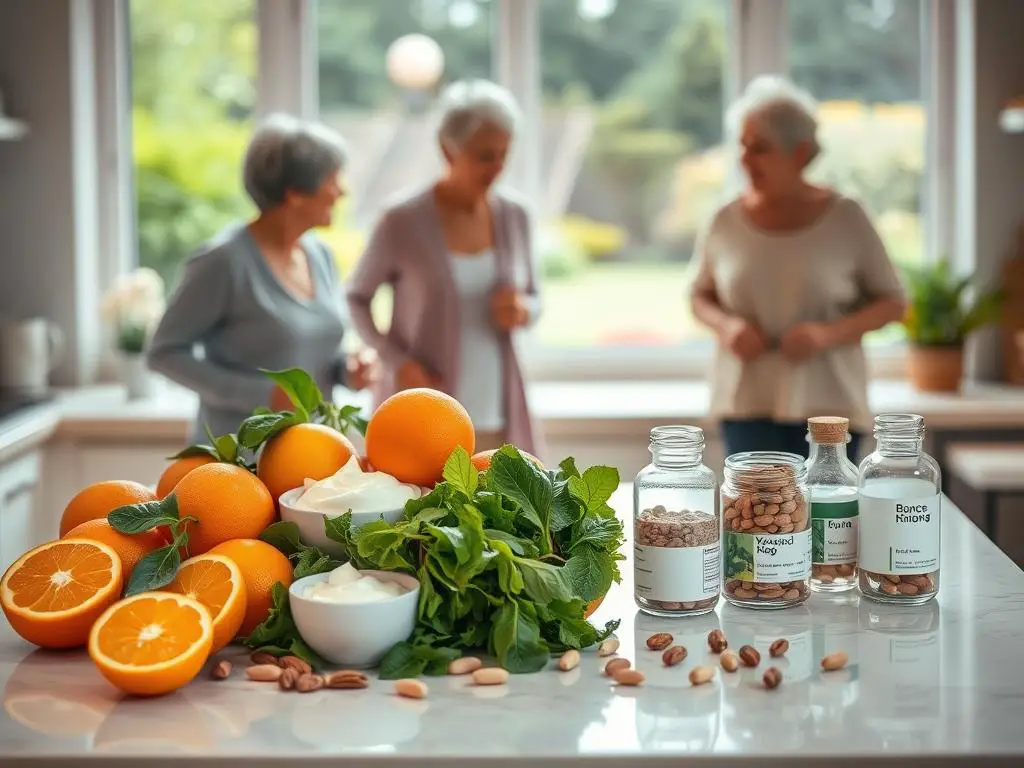
Essential Nutrients for Bone Health
Several nutrients are crucial for bone strength. Calcium is the foundation, but vitamin D helps your body use it. Magnesium and vitamin K also play important roles.
Magnesium helps turn vitamin D into its active form. About 60% of your magnesium is in your bones. Vitamin K helps proteins bind calcium to bone tissue. You can find it in spinach and kale.
Protein is key for new bone formation. Women over 60 need about 1.2 grams of protein per kilogram of body weight daily. Good sources include lean meats, fish, eggs, and beans.
Calcium and Vitamin D Sources
Knowing what women over 60 need for calcium and vitamin D helps you make better food choices. Women in this age group need 1,200 milligrams of calcium daily. Dairy products like milk, yogurt, and cheese provide easily absorbed calcium.
Non-dairy sources include canned salmon with bones, sardines, and fortified plant milks. Dark leafy greens like collard greens and bok choy also contain calcium. However, some greens like spinach have compounds that reduce calcium absorption.
Vitamin D needs increase with age. Women over 60 need 800 international units daily. Your skin makes vitamin D when exposed to sunlight, but this process becomes less efficient as you age. Fatty fish like salmon and tuna provide vitamin D naturally.
Timing matters for absorption. Take calcium supplements in doses of 500 milligrams or less. Your body absorbs smaller amounts more effectively. Avoid taking calcium with iron supplements as they compete for absorption.
Hydration and Its Impact on Bone Strength
Water plays a surprising role in bone health. Proper hydration helps transport nutrients to bone cells and removes waste products. Dehydration can interfere with the bone remodeling process.
Aim for eight glasses of water daily, but adjust based on your activity level and climate. Herbal teas and water-rich foods like soups and fruits count toward your fluid intake. Limit caffeine and alcohol as they can increase calcium loss through urine.
Consider the sodium content in your diet too. High sodium intake forces your kidneys to excrete more calcium. Choose fresh foods over processed ones when possible to keep sodium levels in check.
Gentle Exercises to Ease Joint Pain
Many women over 60 find that gentle movement helps reduce joint pain and strengthens bones. The beauty of gentle exercises for senior women joint pain is that they offer big benefits without discomfort. These activities improve circulation, reduce stiffness, and build bone density through low-impact movements.
Gentle exercise and bone health are closely linked. Moving your joints helps stimulate bone-building cells and keeps them flexible. This helps prevent joint pain from leading to inactivity, which weakens bones.
Importance of Flexibility and Mobility
Flexibility and mobility are key to healthy aging. Flexible joints move more easily, lowering injury risk in daily activities. When joints move freely, bones get gentle stress that encourages new bone growth.
Regular mobility work also boosts balance and coordination. This is crucial as we age, as better balance means fewer falls and fractures. Mobility exercises also increase blood flow to bones, delivering nutrients for strength.
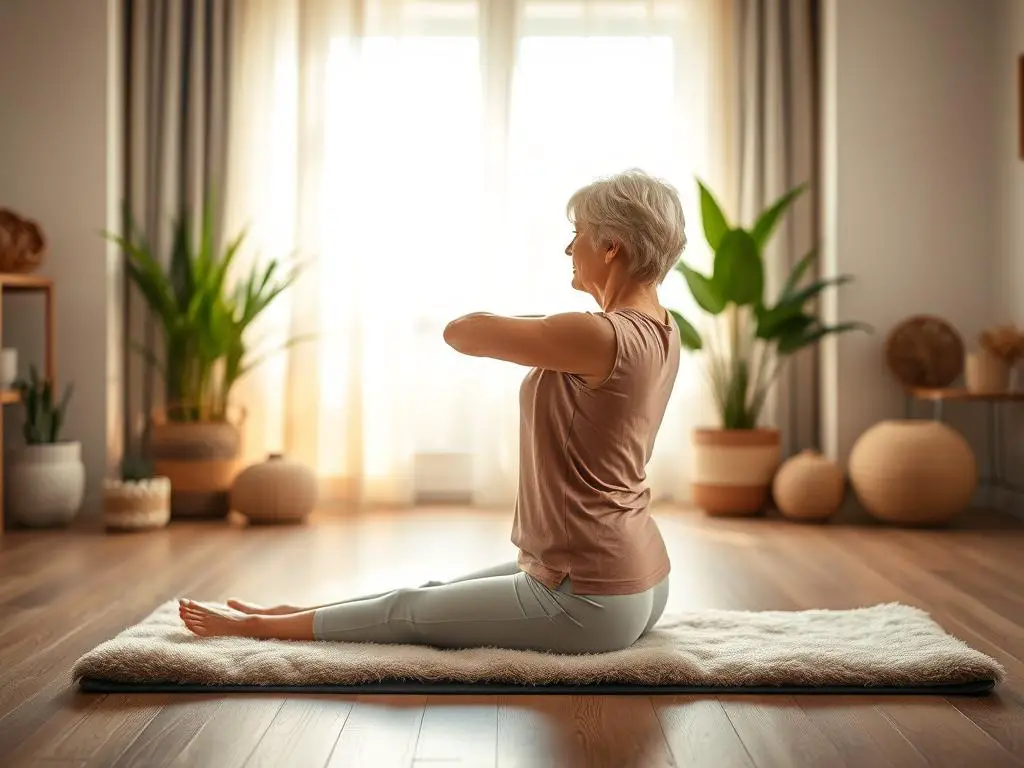
Recommended Gentle Exercises
Low impact bone strengthening exercises are great for women with joint discomfort. Water aerobics is a top choice because water supports your body and provides resistance. This reduces joint stress by up to 90% while still challenging bones.
Tai chi is another excellent option. It combines slow movements with weight-bearing positions. Studies show tai chi can improve bone density and reduce fall risk. Its gentle nature makes it perfect for beginners or those with arthritis.
Chair exercises are accessible for everyone. Simple movements like seated marching, arm circles, and twists can be done safely. These exercises keep joints mobile and provide light resistance training for bones.
- Water walking and gentle swimming strokes
- Modified yoga poses using props for support
- Resistance band exercises with light tension
- Balance exercises using a sturdy chair
Stretching Routines for Better Flexibility
A good stretching routine targets major muscle groups and joints. Start with gentle neck rolls and shoulder shrugs to release tension. These simple movements can be done anywhere and help maintain mobility in areas prone to stiffness.
Hold stretches for 20-30 seconds instead of bouncing. This allows muscles to lengthen gradually without triggering reflexes. Gentle hip circles and ankle rotations keep lower body joints flexible and support better walking.
Morning stretches prepare your body for daily activities. Simple movements like reaching overhead, gentle spinal twists, and calf stretches can be done right after waking. Evening stretches help release tension accumulated throughout the day.
Consistency is more important than intensity. Even five minutes of gentle stretching daily provides more benefits than occasional longer sessions. The key is finding movements that feel good and gradually increasing your range of motion over time.
Incorporating Balance and Stability Workouts
Every step you take needs your body to stay balanced. This skill is key as we get older. Balance and stability training is vital for bone health in women over 60. It builds a strong base for your bones and boosts your confidence in moving around.
Improving your balance does more than prevent falls. It makes your muscles, joints, and nervous system work better together. This teamwork helps your body react fast to changes and keeps you standing straight all day.
Why Balance Is Crucial After 60
Your balance system changes with age, making fall prevention exercises for senior women a must. The inner ear, vision, and muscle sensors that control balance get weaker. Without regular training, you might lose your balance and fall more easily.
Poor balance can harm your bones because falls often cause fractures. Women over 60 are at higher risk of fractures due to weaker bones. Balance training helps your body stay steady and recover from stumbles.
Regular balance work also boosts your proprioception – your body’s sense of where it is in space. This better awareness helps you move safely on stairs, uneven surfaces, and in crowded places.
Effective Balance Exercises to Try
Simple balance exercises for women over 60 can be done at home without special gear. Start with single-leg stands, using a chair for support. Try to balance on one foot for 10-30 seconds before switching legs.
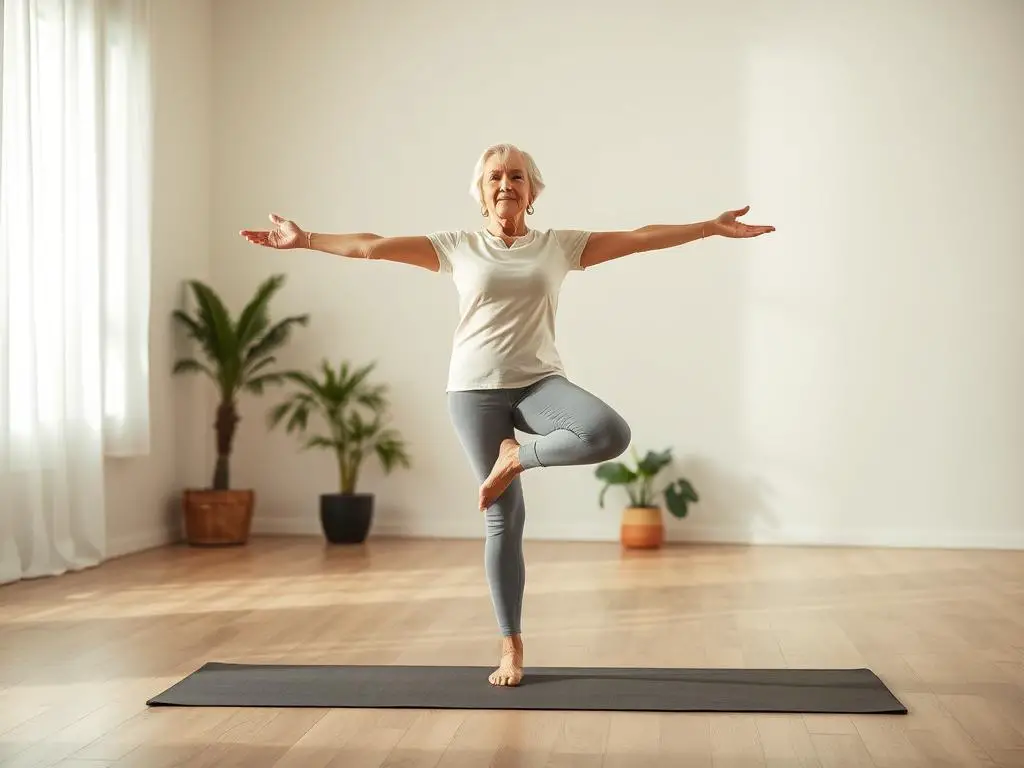
Heel-to-toe walking is great for balance. Walk in a straight line, placing one foot directly in front of the other. This exercise challenges your stability and improves coordination and awareness of your space.
Try these additional exercises to build your balance foundation:
- Standing weight shifts from side to side
- Gentle leg swings while holding support
- Standing on tiptoes for 5-10 seconds
- Marching in place with high knees
Tools to Enhance Balance Training
Balance pads and foam cushions make basic exercises harder by creating unstable surfaces. These tools make your muscles work harder to stay stable. Start with firmer surfaces and move to softer ones as you get better.
Stability balls offer versatile training options for seated and standing exercises. Sitting on a stability ball while doing arm movements works your core and improves balance.
Resistance bands add strength training to balance exercises. Use them for supported leg lifts or gentle stretching movements that improve flexibility and stability at the same time.
The Impact of Lifestyle Choices on Bone Health
Your daily habits greatly affect your bone strength as you get older. While exercise and nutrition are key, other lifestyle factors affecting bone health in women are just as important. Making good changes in these areas can really help your bone density over time.
Knowing how your daily choices impact your bones helps you make better choices. Even small changes can lead to big benefits for your bone health in the long run.
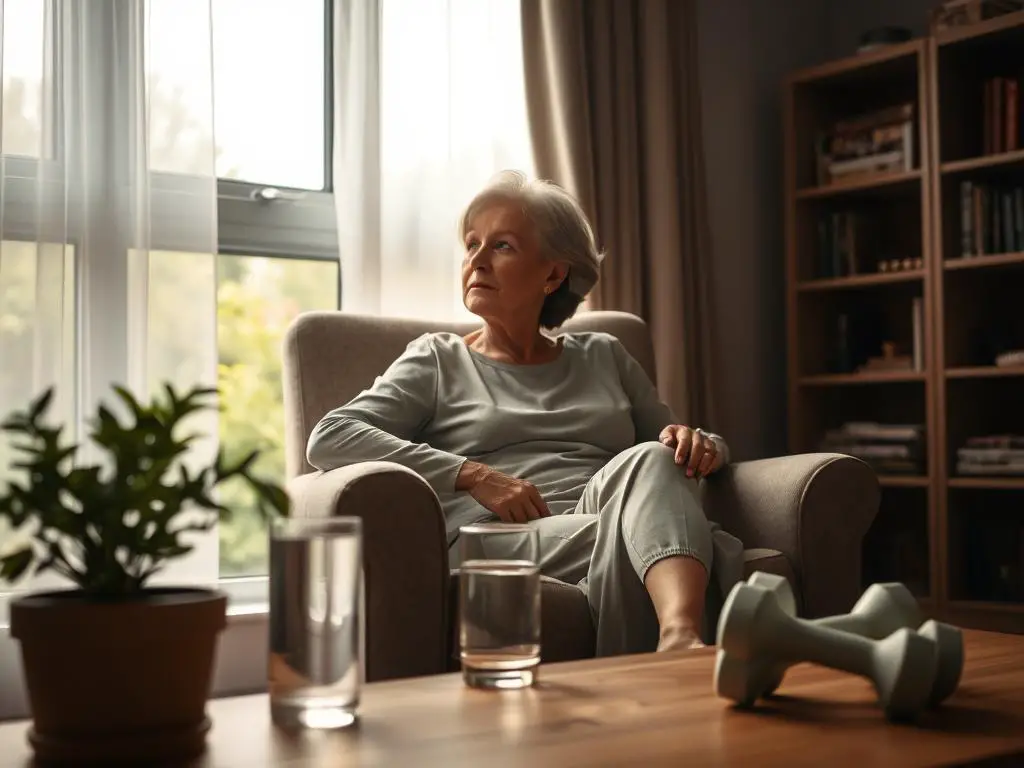
Smoking and Its Effects on Bones
Smoking harms bone health in many ways. It makes it harder for your body to absorb calcium. It also lowers estrogen levels, which are key for bone density in women.
Cigarettes damage blood vessels that feed your bones. This means your bones get less oxygen and nutrients. Smoking effects on bones get worse with age, speeding up bone loss.
Stopping smoking at any age helps your bones right away. Within weeks, your bones start getting more nutrients. Your body absorbs calcium better, slowing bone loss.
The Role of Alcohol in Bone Density
Alcohol’s impact on bones is complex and depends on how much you drink. Drinking too much disrupts bone formation and makes it harder to absorb calcium and vitamin D.
Drinking in moderation might help postmenopausal women. But moderation means no more than one drink a day. Drinking more than that can harm your bones more than it helps.
If you drink, do it with meals to lessen its impact. Always make sure you get enough calcium and vitamin D.
How Stress Affects Bone Health
Chronic stress leads to hormonal changes that hurt bones. Stress makes your body produce too much cortisol. This hormone breaks down bones faster and slows down making new ones.
Stress also changes your habits, which affects bones. You might eat less, exercise less, or sleep poorly. These changes make stress’s impact on bones worse.
Managing stress well helps your bones. Relaxation, enough sleep, and staying connected with others lower cortisol levels. Simple stress management can be as good as supplements for bones.
Remember, smoking alcohol effects on bone density senior women can be reversed with better habits. It’s never too late to start healthier habits for stronger bones.
Community Resources for Senior Fitness
Finding the right community resources can change how you view senior fitness. Many women over 60 find that good facilities, expert advice, and supportive groups make a big difference. There are many options to help you stay active and strengthen your bones, no matter your budget or fitness level.
Your local community likely has more senior fitness programs for women than you think. From special classes to online platforms, these resources offer the structure and motivation you need for success.
Local Fitness Centers and Classes
Community centers and local gyms are great places to start with bone-strengthening exercises. Many YMCAs offer SilverSneakers programs for older adults. These programs include low-impact activities that help bones while being easy on joints.
Senior fitness programs for women at local facilities have certified instructors who know what older adults need. Water aerobics classes are great for resistance training without stressing bones and joints. Many centers also have chair exercises and gentle yoga for beginners.
Local hospitals and wellness centers often host classes to improve bone density. The instructors are trained to work with women with osteoporosis or other bone concerns.
Online Resources for Home Workouts
The internet offers amazing opportunities for home-based exercises. YouTube channels for senior fitness provide free lessons from home. Many of these channels have exercises for women over 60.
Fitness apps like SilverSneakers GO and 7 Minute Workout offer structured programs. These apps track your progress and offer modifications for different levels. Some apps even have live classes where you can interact with instructors and others.
Support Groups for Motivation
Connecting with others who have similar health goals can motivate you to keep exercising. Local support groups for women over 60 meet at community centers, libraries, or churches. They often organize walking clubs and group exercise sessions.
Having an exercise buddy can help you stick to your routine. Many communities pair women with similar fitness goals and schedules. This partnership adds accountability and makes exercising more fun.
Online forums and social media groups also offer support. Facebook groups for senior fitness let you share experiences, ask questions, and celebrate achievements with women nationwide. These digital communities offer 24/7 support and advice.
Local senior centers often organize group activities that combine socializing with physical activity. Book clubs that meet for walks, gardening groups, and volunteer activities that involve physical activity all help improve bone health while building relationships.
Monitoring Bone Health
Knowing your bone health helps you make better choices for your wellness. Monitoring bone health in elderly women guides your exercise and lifestyle. Regular checks help you avoid problems and celebrate successes.
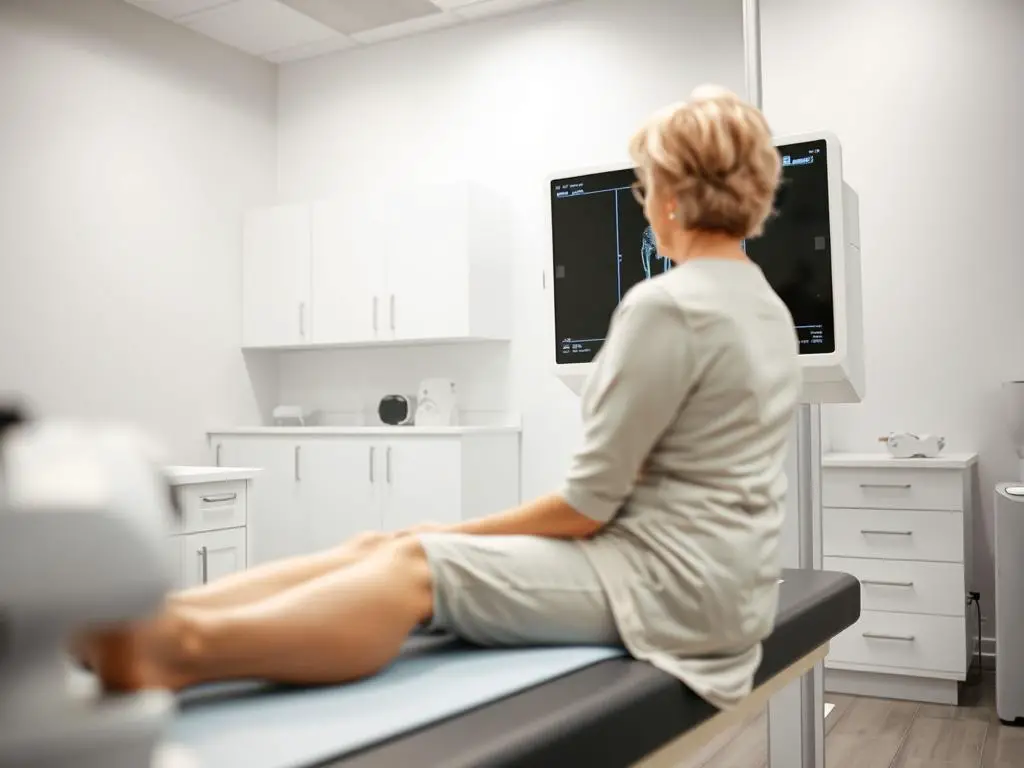
Regular Screenings Make a Difference
Bone density testing for women over 60 is like a health compass. DEXA scans measure bone mineral density accurately. These quick tests give you detailed info about your bones.
Your test results show how your bones compare to others. A T-score above -1.0 means your bones are healthy. Scores between -1.0 and -2.5 suggest osteopenia. Knowing these numbers helps you and your doctor plan the best treatment.
Most women should get their first DEXA scan at 65, or sooner if you’re at risk. You’ll usually get tested every two years. But, your doctor might suggest more frequent tests based on your health.
Recognizing Warning Signs Early
Your body often gives early signs of bone health changes. Height loss of more than 1.5 inches from your peak height can mean vertebral compression fractures. Notice any changes in your posture or forward head position.
More frequent minor fractures, especially from low-impact activities, need attention. Breaking a bone from a fall at walking speed or less shows weak bones. Also, persistent back pain, especially in the middle or lower spine, is a warning sign.
Keep a journal of any unusual aches or changes in your stance. This info is very helpful during doctor visits and helps track patterns over time.
Building Strong Healthcare Partnerships
Working with healthcare professionals makes monitoring bone health a team effort. Your primary care doctor can set up initial screenings and refer you to specialists. Endocrinologists focus on bone metabolism, and physical therapists create exercise plans for you.
Be ready for appointments by listing your medications, supplements, and symptoms. Ask about exercise, diet, and treatment options. Don’t hesitate to ask for clarification about test results or treatment plans.
Ask for copies of your test results to track your progress. Many healthcare systems offer patient portals for easy access. Building strong partnerships ensures you get comprehensive care for your bone health.
Overcoming Barriers to Exercise
Many women over 60 face mental and emotional barriers to exercise, not just physical ones. Overcoming exercise barriers for senior women means recognizing these obstacles are normal and temporary. Every woman has her own challenges, but knowing common ones helps you find solutions.
Building stronger bones doesn’t need to be perfect. It’s about being persistent and kind to yourself as you tackle each challenge.
Common Challenges for Seniors
Fear of injury is a big worry for many women after 60. This fear often comes from past experiences or stories from friends. Your body is more resilient than you think, especially when you start slow and listen to your body.
Feeling too tired to exercise is another big challenge. Many women don’t realize that gentle movement can actually boost energy levels over time. Start with just five minutes of activity and gradually increase it.
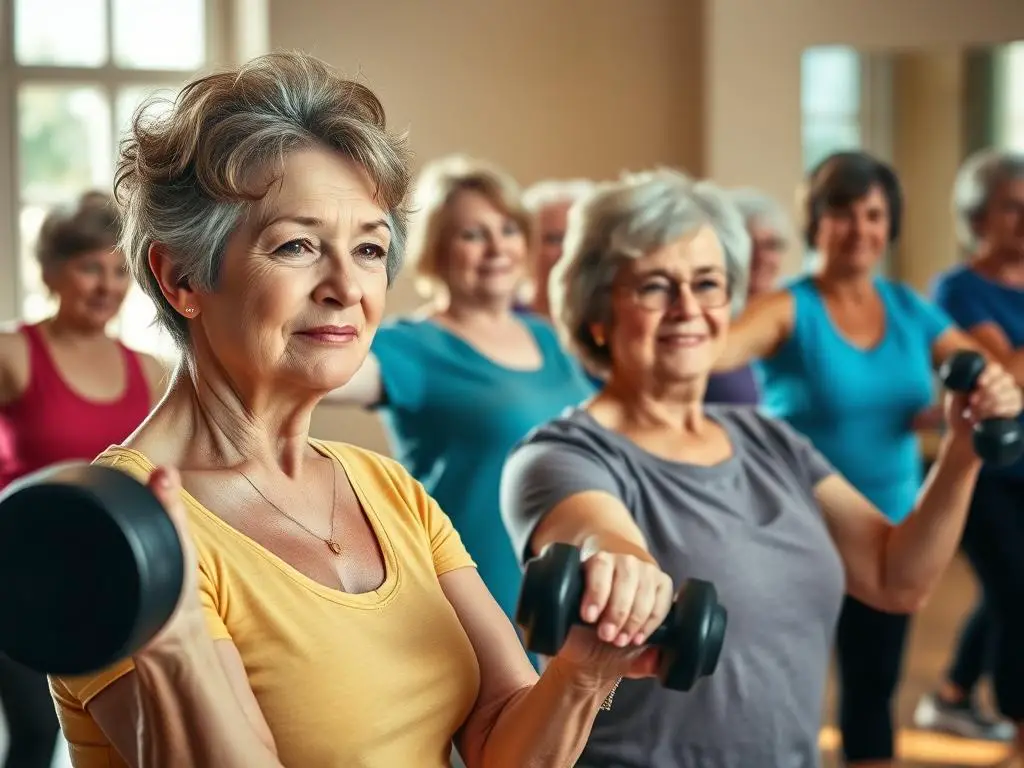
Time constraints can be overwhelming, especially when caring for family or managing health appointments. But, bone-strengthening exercises don’t need hours at the gym. Even 15-minute sessions three times per week can make a big difference.
Physical limitations from arthritis, balance issues, or chronic conditions can seem like big obstacles. But, most exercises can be modified to fit your current abilities. Try chair exercises, water workouts, or gentle stretching for bone health.
Finding the Right Motivation
Motivation for elderly women fitness is different now. Focus on what’s important to you, like staying independent, keeping up with grandkids, or feeling stronger in daily activities.
Think about your “why” beyond how you look. Maybe you want to carry groceries without strain or play on the floor with grandkids. These meaningful goals create lasting motivation that helps you keep going on tough days.
Connect with other women who share your goals. Whether it’s a walking group, fitness class, or online community, having support makes exercise more fun and lasting.
Celebrate small victories. Notice when climbing stairs feels easier or when you can walk longer distances. These improvements in daily life are powerful motivators to keep going.
Setting Realistic Goals
Setting realistic goals is key to successful exercise habits. Aim for small, achievable steps that build confidence over time. Start with walking for 10 minutes three times per week instead of trying to do an hour every day.
Break big goals into smaller ones. If you want to do a 30-minute strength routine, start with 5-minute sessions. Add two minutes each week until you reach your goal.
Track progress in ways that matter to you. Some women like counting steps, while others focus on how they feel or what activities become easier. Choose metrics that motivate you, not discourage you.
Adjust your expectations based on your current situation. Some weeks will be better than others, and that’s okay. Consistency matters more than perfection when building bone strength and overall health.
Remember, every barrier has a solution, and every small step forward helps. Your journey is unique, and finding what works for you is part of the process.
Success Stories of Women Strengthening Bones
Results speak louder than words, and these women show how focusing on bone health can change lives. Their success stories bone health senior women prove that investing in your bones is worth it. They inspire hope and show that change is possible at any age.
Inspiring Transformations
Maria, a 67-year-old grandmother from Phoenix, started her journey after a wrist fracture. In eighteen months, her bone density improved by 12%. More importantly, she could play with her grandchildren again.
Susan from Denver started exercising at 62 after being diagnosed with osteoporosis. She used walking, light weights, and balance exercises. Her latest DEXA scan showed her spine and hip density improved.
These women over 60 fitness transformations are just a few of many stories. Each woman found that being consistent is more important than being perfect.
Testimonials on Exercise Impact
Real women share how exercise changed their lives:
- Linda, age 64: “I went from being afraid to lift a gallon of milk to deadlifting 50 pounds. My back pain disappeared, and I sleep better than I have in years.”
- Patricia, age 69: “The balance exercises saved me from three potential falls last month. I feel steady and secure on my feet again.”
- Carol, age 61: “My posture improved so much that people ask if I’ve grown taller. I stand straighter and feel more confident in social situations.”
- Janet, age 66: “Weight-bearing exercises gave me the strength to garden again. I can kneel, dig, and plant without worrying about my bones.”
Benefits Beyond Bone Health
These women found that strengthening bones has many benefits. Better sleep quality was a surprise benefit for many. They reported deeper, more restful nights after starting exercise routines.
They also noticed improved mood and reduced anxiety. The endorphins from exercise and the confidence from growing stronger made them feel more optimistic about aging. Social connections grew through group fitness classes and walking clubs.
Independence in daily activities returned for many. Simple tasks like carrying groceries and climbing stairs became easier and pain-free. This newfound ability made life more satisfying and reduced fear of future health challenges.
These success stories show that focusing on bone-strengthening exercises has benefits beyond the skeleton. It enriches every aspect of daily life.
Creating a Personalized Exercise Plan
Building stronger bones needs a plan that fits your life and abilities. Every woman’s path to better bone health is unique. The right plan helps you stay on track and see results.
Assessing Your Current Fitness Level
First, honestly check where you are now. Can you walk up stairs easily? How long can you stand on one foot? Do your joints feel stiff in the morning?
Write down your current abilities without judgment. This baseline helps you start safely and track your progress.
Tailoring Exercises to Your Needs
Your bone strengthening routine should match your preferences and limits. If you have knee problems, try upper body exercises and seated ones. Love being outdoors? Walking and gardening are great.
Hate gyms? Bodyweight exercises at home are perfect.
How to Track Your Progress
Keep a simple log of your workouts and how you feel. Mark days when you exercise. Take monthly photos or measurements.
Celebrate small victories like climbing stairs easier or feeling more balanced. These records show your progress and keep you motivated.
Your bones have supported you for decades. Now, it’s time to support them with enjoyable, fitting movement.
FAQ
What are the best bone-strengthening exercises for women over 60 who are just starting out?
Walking is a great start for beginners. It’s easy on the joints and strengthens bones. Dancing, stair climbing, and modified push-ups are also good choices.
Chair exercises and gentle resistance band workouts are perfect for those with mobility issues. Start slow and increase intensity as you get stronger.
How often should women over 60 exercise to strengthen their bones?
Do weight-bearing exercises 4-5 times a week. Resistance training should be done 2-3 times a week. Even short sessions can help a lot.
Balance and flexibility exercises can be done daily. They help prevent falls.
Is it safe for women over 60 to lift weights for bone health?
Yes, it’s safe and effective. Start with light weights or resistance bands. Use proper form and gradually increase weight.
Always warm up before exercising. Working with a trainer can help ensure you’re doing it right.
Can I strengthen my bones if I have arthritis or joint pain?
Yes, there are gentle exercises that can help. Water aerobics, tai chi, and chair exercises are good options. They’re easy on the joints.
Always talk to your doctor before starting any new exercise.
What nutrients are most important for bone health in women over 60?
Calcium, vitamin D, magnesium, vitamin K, and protein are key. Find them in dairy, leafy greens, salmon, and fortified foods. Drinking enough water also helps.
How long does it take to see improvements in bone density from exercise?
You might feel stronger in a few weeks. But, real bone density gains take 6-12 months of regular exercise. Consistency is key, not how hard you exercise.
What are the warning signs that I might have bone loss or osteoporosis?
Look out for losing height, changes in posture, back pain, and fractures from minor falls. Osteoporosis often has no symptoms. Regular bone density tests are important.
Can balance exercises really help prevent fractures?
Yes! Balance training is key to preventing falls and fractures. Single-leg stands, heel-to-toe walking, and tai chi improve stability. Even short daily sessions can make a big difference.
Are there any exercises I should avoid if I’m concerned about bone health?
Avoid high-impact activities if you have osteoporosis or a history of fractures. Be cautious with exercises that bend your spine too much. Focus on weight-bearing and resistance training with proper form.
Always check with your doctor about any exercise restrictions.
How do lifestyle factors like smoking and alcohol affect bone health?
Smoking weakens bones by affecting calcium absorption and estrogen levels. Too much alcohol can also harm bone formation. Chronic stress can lead to bone loss. Making healthy lifestyle changes can help your bones at any age.
Where can I find senior-friendly fitness programs in my community?
Look for classes at YMCAs, community centers, and senior centers. SilverSneakers and water aerobics are great options. There are also online classes and apps designed for older adults.
What should I expect during a bone density test?
A DEXA scan is quick, painless, and non-invasive. It’s like an X-ray. The test takes 15-30 minutes and gives important information about your bone health.
Most women should have their first scan around age 65. Your doctor will let you know if you need one sooner.
